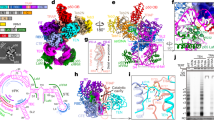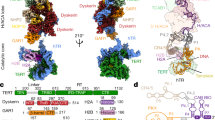Abstract
Telomerase, a ribonucleoprotein enzyme, adds telomeric DNA repeats to the ends of linear chromosomes. Here we report the first high-resolution structure of any portion of the telomerase reverse transcriptase, the telomerase essential N-terminal (TEN) domain from Tetrahymena thermophila. The structure, which seems to represent a novel protein fold, shows phylogenetically conserved amino acid residues in a groove on its surface. These residues are crucial for telomerase catalytic activity, and several of them are required for sequence-specific binding of a single-stranded telomeric DNA primer. The positively charged C terminus, which becomes ordered upon interaction with other macromolecules, is involved in binding RNA in a non–sequence-specific manner. The TEN domain's ability to bind both RNA and telomeric DNA, coupled with the notably strong effects on activity upon mutagenesis of single surface residues, suggest how this domain contributes to telomerase catalysis.
This is a preview of subscription content, access via your institution
Access options
Subscribe to this journal
Receive 12 print issues and online access
$189.00 per year
only $15.75 per issue
Buy this article
- Purchase on Springer Link
- Instant access to full article PDF
Prices may be subject to local taxes which are calculated during checkout






Similar content being viewed by others
Accession codes
Change history
24 September 2007
The recent paper by Romi et al. (Proc. Natl. Acad. Sci. USA 104, 8791–8796, 2007) was in general agreement with our study of the structure and function of the N-terminal domain of Tetrahymena telomerase reverse transcriptase. However, the two studies disagreed on the effect of a mutation of Trp187 on catalysis, with our study reporting a severe reduction in activity. Upon sequencing the entire gene encoding our W187A mutant, we found that it had a second distant mutation (R812W) in motif C of the reverse transcriptase domain, and we demonstrated that it was the mutation at position 812 that abolished catalytic activity. In addition, we confirmed that authentic W187A telomerase has catalytic activity similar to that of wild-type telomerase. Both studies concur that Trp187 is physically close to the primer-binding site, and in fact Romi et al. have mapped Trp187 as a site of photo-cross-linking to a telomeric DNA primer.
Notes
*NOTE: The recent paper by Romi et al. (Proc. Natl. Acad. Sci. USA 104, 8791-8796, 2007) was in general agreement with our study of the structure and function of the N-terminal domain of Tetrahymena telomerase reverse transcriptase. However, the two studies disagreed on the effect of a mutation of Trp187 on catalysis, with our study reporting a severe reduction in activity. Upon sequencing the entire gene encoding our W187A mutant, we found that it had a second distant mutation (R812W) in motif C of the reverse transcriptase domain, and we demonstrated that it was the mutation at position 812 that abolished catalytic activity. In addition, we confirmed that authentic W187A telomerase has catalytic activity similar to that of wild-type telomerase. Both studies concur that Trp187 is physically close to the primer-binding site, and in fact Romi et al. have mapped Trp187 as a site of photo-cross-linking to a telomeric DNA primer. We gratefully acknowledge the work of Arthur J. Zaug (HHMI, University of Colorado-Boulder) in resolving this discrepancy.
References
Greider, C.W. & Blackburn, E.H. Identification of a specific telomere terminal transferase activity in Tetrahymena extracts. Cell 43, 405–413 (1985).
Greider, C.W. & Blackburn, E.H. A telomeric sequence in the RNA of Tetrahymena telomerase required for telomere repeat synthesis. Nature 337, 331–337 (1989).
Lingner, J. & Cech, T.R. Purification of telomerase from Euplotes aediculatus: requirement of a primer 3′ overhang. Proc. Natl. Acad. Sci. USA 93, 10712–10717 (1996).
Lingner, J. et al. Reverse transcriptase motifs in the catalytic subunit of telomerase. Science 276, 561–567 (1997).
Nakamura, T.M. & Cech, T.R. Reversing time: origin of telomerase. Cell 92, 587–590 (1998).
Yap, W.H., Yeoh, E., Brenner, S. & Venkatesh, B. Cloning and expression of the reverse transcriptase component of pufferfish (Fugu rubripes) telomerase. Gene 353, 207–217 (2005).
Weinrich, S.L. et al. Reconstitution of human telomerase with the template RNA component hTR and the catalytic protein subunit hTRT. Nat. Genet. 17, 498–502 (1997).
Bryan, T.M., Goodrich, K.J. & Cech, T.R. Telomerase RNA bound by protein motifs specific to telomerase reverse transcriptase. Mol. Cell 6, 493–499 (2000).
Lai, C.K., Mitchell, J.R. & Collins, K. RNA binding domain of telomerase reverse transcriptase. Mol. Cell. Biol. 21, 990–1000 (2001).
Lue, N.F. A physical and functional constituent of telomerase anchor site. J. Biol. Chem. 280, 26586–26591 (2005).
Friedman, K.L., Heit, J.J., Long, D.M. & Cech, T.R. N-terminal domain of yeast telomerase reverse transcriptase: recruitment of Est3p to the telomerase complex. Mol. Biol. Cell 14, 1–13 (2003).
Friedman, K.L. & Cech, T.R. Essential functions of amino-terminal domains in the yeast telomerase catalytic subunit revealed by selection for viable mutants. Genes Dev. 13, 2863–2874 (1999).
Xia, J., Peng, Y., Mian, I.S. & Lue, N.F. Identification of functionally important domains in the N-terminal region of telomerase reverse transcriptase. Mol. Cell. Biol. 20, 5196–5207 (2000).
Jacobs, S.A., Podell, E.R., Wuttke, D.S. & Cech, T.R. Soluble domains of telomerase reverse transcriptase identified by high-throughput screening. Protein Sci. 14, 2051–2058 (2005).
O'Connor, C.M., Lai, C.K. & Collins, K. Two purified domains of telomerase reverse transcriptase reconstitute sequence-specific interactions with RNA. J. Biol. Chem. 280, 17533–17539 (2005).
Holm, L. & Sander, C. Mapping the protein universe. Science 273, 595–603 (1996).
Harrison, A. et al. Recognizing the fold of a protein structure. Bioinformatics 19, 1748–1759 (2003).
Shindyalov, I.N. & Bourne, P.E. Protein structure alignment by incremental combinatorial extension (CE) of the optimal path. Protein Eng. 11, 739–747 (1998).
Kawabata, T. MATRAS: A program for protein 3D structure comparison. Nucleic Acids Res. 31, 3367–3369 (2003).
Armbruster, B.N., Banik, S.S., Guo, C., Smith, A.C. & Counter, C.M. N-terminal domains of the human telomerase catalytic subunit required for enzyme activity in vivo. Mol. Cell. Biol. 21, 7775–7786 (2001).
Moriarty, T.J., Huard, S., Dupuis, S. & Autexier, C. Functional multimerization of human telomerase requires an RNA interaction domain in the N terminus of the catalytic subunit. Mol. Cell. Biol. 22, 1253–1265 (2002).
Bryan, T.M., Goodrich, K.J. & Cech, T.R. Tetrahymena telomerase is active as a monomer. Mol. Biol. Cell 14, 4794–4804 (2003).
Chenna, R. et al. Multiple sequence alignment with the Clustal series of programs. Nucleic Acids Res. 31, 3497–3500 (2003).
Altschul, S.F. et al. Gapped BLAST and PSI-BLAST: a new generation of protein database search programs. Nucleic Acids Res. 25, 3389–3402 (1997).
Bryan, T.M., Goodrich, K.J. & Cech, T.R. A mutant of Tetrahymena telomerase reverse transcriptase with increased processivity. J. Biol. Chem. 275, 24199–24207 (2000).
Hammond, P.W., Lively, T.N. & Cech, T.R. The anchor site of telomerase from Euplotes aediculatus revealed by photo-cross-linking to single- and double-stranded DNA primers. Mol. Cell. Biol. 17, 296–308 (1997).
Moriarty, T.J., Marie-Egyptienne, D.T. & Autexier, C. Functional organization of repeat addition processivity and DNA synthesis determinants in the human telomerase multimer. Mol. Cell. Biol. 24, 3720–3733 (2004).
Handa, N. et al. Structural basis for recognition of the tra mRNA precursor by the Sex-lethal protein. Nature 398, 579–585 (1999).
Deo, R.C., Bonanno, J.B., Sonenberg, N. & Burley, S.K. Recognition of polyadenylate RNA by the poly(A)-binding protein. Cell 98, 835–845 (1999).
Moriarty, T.J., Ward, R.J., Taboski, M.A. & Autexier, C. An anchor site-type defect in human telomerase that disrupts telomere length maintenance and cellular immortalization. Mol. Biol. Cell 16, 3152–3161 (2005).
Lue, N.F. et al. Telomerase can act as a template- and RNA-independent terminal transferase. Proc. Natl. Acad. Sci. USA 102, 9778–9783 (2005).
Lee, S.R., Wong, J.M. & Collins, K. Human telomerase reverse transcriptase motifs required for elongation of a telomeric substrate. J. Biol. Chem. 278, 52531–52536 (2003).
Greider, C.W. Telomerase is processive. Mol. Cell. Biol. 11, 4572–4580 (1991).
Brodersen, D.E., Clemons, W.M., Jr., Carter, A.P., Wimberly, B.T. & Ramakrishnan, V. Crystal structure of the 30 S ribosomal subunit from Thermus thermophilus: structure of the proteins and their interactions with 16 S RNA. J. Mol. Biol. 316, 725–768 (2002).
Klein, D.J., Moore, P.B. & Steitz, T.A. The roles of ribosomal proteins in the structure assembly, and evolution of the large ribosomal subunit. J. Mol. Biol. 340, 141–177 (2004).
Otwinowski, Z. & Minor, W. Processing of X-ray diffraction data in oscillation mode. Methods Enzymol. 276, 307–326 (1997).
Terwilliger, T.C. & Berendzen, J. Automated MAD and MIR structure solution. Acta Crystallogr. D Biol. Crystallogr. 55, 849–861 (1999).
Terwilliger, T.C. Automated main-chain model building by template matching and iterative fragment extension. Acta Crystallogr. D Biol. Crystallogr. 59, 38–44 (2003).
Terwilliger, T.C. Maximum-likelihood density modification. Acta Crystallogr. D Biol. Crystallogr. 56, 965–972 (2000).
Perrakis, A., Morris, R. & Lamzin, V.S. Automated protein model building combined with iterative structure refinement. Nat. Struct. Biol. 6, 458–463 (1999).
Brunger, A.T. et al. Crystallography & NMR system: A new software suite for macromolecular structure determination. Acta Crystallogr. D Biol. Crystallogr. 54, 905–921 (1998).
Szewczak, A.A., Podell, E.R., Bevilacqua, P.C. & Cech, T.R. Thermodynamic stability of the P4–P6 domain RNA tertiary structure measured by temperature gradient gel electrophoresis. Biochemistry 37, 11162–11170 (1998).
Lu, G. TOP: A new method for protein structure comparisons and similarity searches. J. Appl. Crystallogr. 33, 176–183 (2000).
Nicholls, A., Sharp, K. & Honig, B. Graphical representation and analysis of structural properties. PROTEINS, Structure, Function and Genetics 11, 281 (1991).
Acknowledgements
We thank A.J. Zaug and A. Gooding for help with X-ray diffraction data collection, the Advanced Light Source for beam time and helpful advice and L. Chen, D.S. Wuttke and M. Sousa for helpful discussions. S.A.J. was a Damon Runyon fellow supported by the Damon Runyon Cancer Research Foundation (grant DRG-#1821-04).
Author information
Authors and Affiliations
Corresponding author
Ethics declarations
Competing interests
The authors declare no competing financial interests.
Supplementary information
Supplementary Fig. 1
SDS gel showing expression levels of the mutant TERT proteins (PDF 3554 kb)
Rights and permissions
About this article
Cite this article
Jacobs, S., Podell, E. & Cech, T. Crystal structure of the essential N-terminal domain of telomerase reverse transcriptase. Nat Struct Mol Biol 13, 218–225 (2006). https://doi.org/10.1038/nsmb1054
Received:
Accepted:
Published:
Issue Date:
DOI: https://doi.org/10.1038/nsmb1054
This article is cited by
-
Conformational plasticity and allosteric communication networks explain Shelterin protein TPP1 binding to human telomerase
Communications Chemistry (2023)
-
Orchestrating nucleic acid–protein interactions at chromosome ends: telomerase mechanisms come into focus
Nature Structural & Molecular Biology (2023)
-
Structures of telomerase at several steps of telomere repeat synthesis
Nature (2021)
-
Observation of processive telomerase catalysis using high-resolution optical tweezers
Nature Chemical Biology (2020)
-
Tandem affinity purification of AtTERT reveals putative interaction partners of plant telomerase in vivo
Protoplasma (2017)



